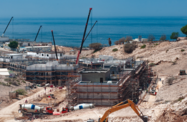With an increase in both government and private sector spending as a series of new infrastructure, tourism and social services projects are rolled out, Oman’s construction sector is set to experience robust growth in the coming years. The sheer scale of the building programme, however, could test the capacity of the industry.
The Omani government is set to invest up to $10bn in 2012 in construction work, which represents a 23% increase on the total outlay for 2011, according to Abdullah Bin Rashid Al Kiyumi, director-general of projects at the Ministry of Housing. Al Kiyumi told delegates attending a summit on construction at the end of January that this increased spending is a reflection of the importance of the industry to the national economy.
“Spending will continue apace on a wide array of infrastructure projects, such as roads, ports, airports, water supply schemes, sewerage treatment plants, real estate projects and dozens of schools and hospitals. Construction of the OR1bn ($2.6bn) Batinah Expressway project will get underway as well, while private sector investment in tourism and leisure-related ventures is envisaged in a major way,” he said.
While some of the projected $10bn construction expenditure was previously announced in last year’s budget and represents longer-term developments, the 2012 budget, released in early January, provided funding for more than $4bn worth of new developments, including 29 schools, five hospitals and extensive waterworks projects.
According to a late 2011 report by industry consultancy Ventures Middle East, more than $27bn is expected to flow into the Omani construction sector over the next three years, with the investments spread among housing, commercial, hospitality and infrastructure projects.
Real estate analysts Cluttons have estimated that retail space in Oman will increase by more than 30% by the middle of 2013. In addition, more than 2000 new hotel rooms are under construction in Muscat, which will add almost 50% to the existing accommodation stock in the capital.
Indeed, tourism will continue to play a major role in boosting the construction industry for the rest of this decade at a minimum, with the Ministry of Tourism projecting visitor numbers will increase from 1.6m in 2011 to 12m by 2020. This will necessitate a steady stream of hotels, resorts, entertainment facilities and retail space.
Infrastructure developments are another pillar supporting the industry. Both the state and private sector will invest heavily in new power production and transmission capacity over the next five years to meet rising demand for electricity and desalinated water.
The government’s push to expand industrial capacity will be key to the sector’s medium-term growth, with the Duqm Development the centrepiece. The multi-billion-dollar centre on the Arabian Sea coast will be home to a massive port and dry dock complex, a large-scale industrial zone, tourism facilities and residential areas.
It is not just the state that will be fuelling construction growth. The private sector is increasing its building spend. In late February, for example, the Abu Dhabi-based construction company Ghantoot Group announced it would be investing $500m in new projects in Oman, ranging from power stations to tourism facilities.
There can be no doubt that the jump in spending will be a bonanza for the construction industry, though there is a question as to whether the increased flow of investments could be too much of a good thing. The sheer scale of the demands to be put on the industry in 2012 and the years beyond will test the capacity of Oman’s construction companies to keep such a broad range of projects on schedule.
This strong demand could also see an increase in costs, with both skilled labour and materials being at a premium. As construction gains momentum in other Gulf states as well – most notably in Saudi Arabia and Qatar, which are allocating billions to new building developments – this year and beyond could see wage and materials increase, and supply could struggle to meet heightened demand across the region.
Despite the pressure to keep developing projects on track, and facing the risk of rising costs, Oman’s construction industry should be well placed to enjoy a period of sustained, though possibly hectic, growth in the coming years.

